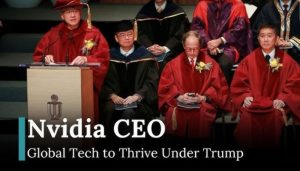‘Amazing Grace’: The Story Behind Nvidia’s $2 Trillion Chip Empire

Rear Admiral Grace Hopper, the inspiration for the tech giant’s latest superchip, was a pioneer in the concept of automatic programming
In the dry landscape of semiconductor manufacturing, one processor the size of a hardback book stands out: Nvidia’s H-100. Last Friday, the Santa Clara, California, company exceeded a $2 trillion valuation. Its future direction will be influenced by a chip named after “Amazing Grace” Hopper, a US Navy Rear Admiral who played a key role in the advancement of programming language design and implementation.
Nvidia dominates about 80% of the global market for chips used in AI applications. According to the Wall Street Journal, the company’s H-100 chips, named after Hopper, are now so valuable that they require transportation by armored car, and demand is so high that some customers are waiting up to six months to receive them.
The significance of Hopper to Nvidia and AI computing was highlighted last summer when Jensen Huang, the founder and CEO of Nvidia, named the company’s next generation of accelerated computing and generative AI chips the GH200 Grace Hopper Superchip.
Hopper was born in 1906 in New York City. She graduated from Vassar College with degrees in mathematics and physics in 1928. Following the US entry into World War II after the bombing of Pearl Harbor, she joined the navy.
According to a biography from Yale University, she was initially turned down by the navy due to her age and small stature. However, once commissioned, she was assigned to the Bureau of Ships computation project at Harvard. There, she worked on the Mark I, the first US electromechanical computer, calculating rocket trajectories, anti-aircraft gun range tables, and calibrating minesweepers.
Following the war, Hopper joined the Eckert-Mauchly Computer Corporation, later Sperry Rand, where she led the way in automatic programming. In 1952, she created the first compiler, a program that translates written instructions into computer code.
“In starting to program in English language, my aim was to enable another entire group of people to use the computer easily… I consistently advocated for more user-friendly languages. Most of what we receive from academics, computer scientists, is in no way suited for regular people,” Hopper explained in a 1980 interview.
Hopper retired from the navy as a rear admiral at 79, becoming the oldest serving officer in the US armed forces. A year before her death in 1992, President George HW Bush awarded her the National Medal of Technology. In 2016, she was posthumously awarded the Presidential Medal of Freedom, the nation’s highest civilian honor.
In a 1983 interview with 60 Minutes, Hopper was asked if the computer revolution had ended. She replied, “No, we’re only at the beginning… We’ve got the Model T.”


